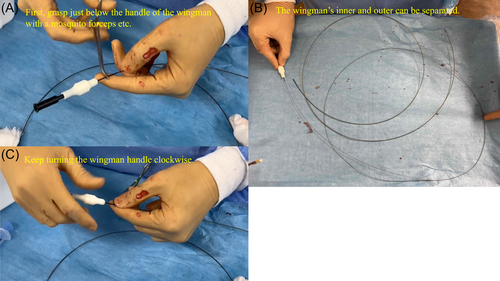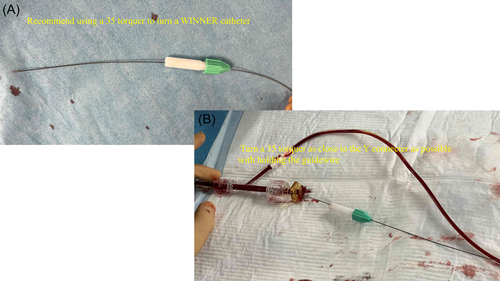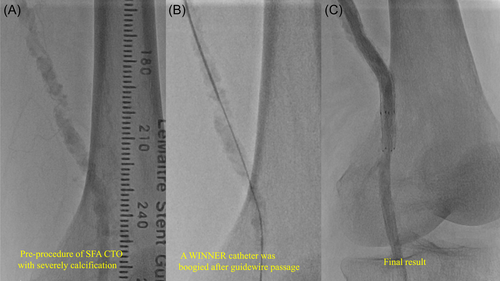Utility and safety of a novel method using a Wingman catheter for patients with lower extremity arterial disease complicated with severely calcified lesions: Wingman's bevel tip inner catheter removal technique—A prospective cohort study
Abstract
Background and Aims
In cases of lower extremity artery disease (LEAD) accompanied by heavily calcified lesions, endovascular treatment becomes necessary at times. To effectively address these challenging calcified lesions, we developed an innovative approach named WINNER (Wingman's bevel tip inner catheter removal) technique. This study investigated the effectiveness and safety of a novel method using the WINNER technique.
Methods
This was a two-center, prospective observational study. We analyzed the clinical data of patients with LEAD complicated with severely calcified lesions who underwent the WINNER technique between January 2021 and December 2022. We investigated the patients' characteristics, target lesions, and intervention results in terms of crossing device rates and periprocedural complications.
Results
A total of 35 patients were treated using the WINNER technique for LEAD complicated by severely calcified lesions. Key patient characteristics were a mean age of 75 ± 9 years, 83% male, 71% hemodialysis, 60% chronic limb-threatening ischemia, and mean lesion length of 147 ± 88 mm. Using the WINNER technique, a device crossing was achieved in 34 patients (97.1%). Wire perforation occurred in one patient, and WINNER catheter rupture occurred in three patients.
Conclusions
The WINNER technique is useful for treating severely calcified lesions, and we should consider using this technique to cross devices for lesions with severe calcifications.
1 INTRODUCTION
Calcification is one of the biggest challenges to achieving technical success in patients with lower extremity artery disease (LEAD).
As reported in previous studies, vascular calcification hinders endovascular procedures, especially in completely calcified lesions.1 Another report indicated that endovascular treatment (EVT) of severely calcified lesions is technically challenging and that calcified lesions are generally difficult to cross with guidewires or balloons.2 We previously demonstrated that severe calcification is an independent predictor of technical success in patients with chronic limb-threatening ischemia (CLTI).3
The Wingman catheter was specially designed and developed to improve chronic total occlusion (CTO) crossing rates by enabling the penetration of the proximal cap to facilitate the delivery of endovascular devices to the target lesion. In addition, the Wingman catheter has a two-layered inner and outer structure, and the bevel tip of the inner catheter consists of a diagonally cut needle. The Wing-IT trial revealed that the Wingman catheter could cross 90% of occlusions with a favorable safety profile.4
The Wingman catheter is useful for crossing CTO lesions. However, we hypothesized that if the inner and outer catheters could be separated, only the inner catheter could be used as a new microcatheter to overcome severely calcified lesions.
The objective of this study was to review the efficacy and safety of a novel method using a Wingman catheter, which we named the WINNER (Wingman bevel tip inner catheter removal) technique.
2 METHODS
2.1 Study design, patients, and inclusion/exclusion criteria
This was a two-center, prospective observational study. A total of 441 EVT procedures were performed at two cardiovascular centers between January 2021 and December 2022.
The inclusion criteria of this study were (1) patients aged ≥20 years with symptomatic lower-limb ischemia, defined as Rutherford categories 2–6, (2) stenotic or occlusive lesions with severely calcified lesions, and (3) lesions that allowed the passage of a guidewire but were not amenable to traversal by other devices, such as microcatheters and balloons.
The exclusion criteria of this study were patients with (1) nonatherosclerotic lesions, (2) acute limb ischemia, (3) aneurysmal lesions, and (4) in-stent restenosis.
After discharge, all patients were followed up at our outpatient clinic within 1 month. This study involved two experienced operators who performed more than 1000 EVTs per individual.
This study was approved by the medical ethics committee of each hospital and was conducted in accordance with the Declaration of Helsinki. Written informed consent was obtained from each patient or their relatives before EVT.
2.2 WINNER technique
The first step to make a new catheter is to grasp just below the handle of the Wingman with mosquito forceps, and so forth (Figure 1A). Next, we have to keep turning the Wingman handle clockwise (Figure 1B). Then, the Wingman's handle and black part are torn off, the inner and outer parts can be separated, and the inner catheter can be used as a new microcatheter with a diagonally sharp tip, which we call the WINNER catheter (Figure 1C).

After a guidewire passes through a severely calcified lesion, this new microcatheter can be used in cases where the calcified lesion cannot be passed with a conventional balloon or microcatheter. The choice of the Wingman depends on the thickness of the passed guidewire. Any Wingman can be used if the Wingman is thicker than the passed guidewire. In addition, a WINNER catheter can be applied to all lower-limb arteries.
We recommend the use of a 35 torquer when passing severely calcified lesions using a WINNER catheter (Figure 2A). With a 35 torquer, we can turn and push the WINNER catheter as close as possible to the Y connecter while keeping a passed guidewire (Figure 2B).

As a tip for advancing a WINNER catheter into a severely calcified lesion, if you keep turning a WINNER catheter in one direction, there might be a possibility of getting stuck with severely calcified lesions; thus, it is important to turn it anticlockwise after turning it clockwise several times.
A representative angiographic sequence of the procedural steps is shown in Figure 3. We penetrated the femoropopliteal artery with a severely calcified lesion using a 35 guidewire (Figure 3A). After passing the 35 guidewires, devices such as balloons or stents were passed through a WINNER catheter, and revascularization was successful (Figure 3B,C).

2.3 Outcome measures
We evaluated the efficacy of using a WINNER catheter as a crossing device and the safety of periprocedural complications. This included monitoring in-hospital death, wire perforation, WINNER catheter rupture, distal embolization, vessel rupture, acute occlusion, surgical conversion, and major adverse events, within a 30-day timeframe.
2.4 Definitions
The definition of symptomatic LEAD included intermittent claudication and CLTI.
CLTI includes a broader and more heterogeneous group of patients with varying degrees of ischemia, which may delay wound healing and increase the risk of amputation.5
Coronary artery disease was defined as a history of myocardial infarction or revascularization of stenotic coronary artery lesions.
Cerebrovascular disease was defined as a history of cerebral infarction or hemorrhage with neurological symptoms sustained for ≥24 h.
Device crossing is defined as the successful passage of severely calcified lesions using a conventional balloon or microcatheter after using a WINNER catheter.
Major adverse events were defined as any cause of death, major amputation, or target lesion revascularization.
2.5 Statistical analysis
The present study was analyzed according to the statistical analyses and methods published previously in guidelines and clinical research.6, 7
Data are presented as mean ± standard deviation or median (interquartile range, 1st–3rd quartile) for continuous variables and as counts and frequencies (percentages) for categorical variables.
All statistical analyses were performed using the JMP version 14.0.0 software (SAS Institute Inc.).
3 RESULTS
A total of 35 consecutive patients who underwent WINNER technique were analyzed in the current analysis.
Table 1 summarizes the patient characteristics.
| Characteristic | n = 35 |
|---|---|
| Age (years) | 74.9 ± 8.7 |
| Male, n (%) | 29 (82.8) |
| Body mass index (kg/m2) | 21.9 ± 6.8 |
| Hypertension, n (%) | 13 (37.1) |
| Diabetes mellitus, n (%) | 26 (74.3) |
| Dyslipidemia, n (%) | 11 (31.4) |
| Chronic kidney disease, n (%) | 12 (34.2) |
| Hemodialysis, n (%) | 25 (71.4) |
| Cerebrovascular disease, n (%) | 6 (17.1) |
| Coronary artery disease, n (%) | 20 (57.1) |
| Arterial fibrillation, n (%) | 2 (5.7) |
| Current smoker, n (%) | 2 (5.7) |
| Chronic limb-threatening ischemia, n (%) | 21 (60.0) |
The mean age was 74.9 ± 8.7 years old, and 82.8% were male. The prevalence rates of diabetes mellitus and hemodialysis were 74.3% and 71.4%, respectively. More than half of the patients had a CLTI.
Most WINNER catheters are used for infrapopliteal artery lesions, followed by femoropopliteal lesions. The percentage of CTO was 71.4%, and the mean lesion length was 147 ± 88 mm. The prevalence of bilateral calcification was approximately 86% (Table 2).
| Characteristic | n = 35 |
|---|---|
| Target vessel, n (%) | |
| Iliac artery | 5 (14.3) |
| Superficial femoral artery | 9 (25.7) |
| Popliteal artery | 3 (8.6) |
| Infrapopliteal artery | 18 (51.4) |
| Lesion characteristics | |
| Chronic total occlusion, n (%) | 25 (71.4) |
| Lesion length (mm) | 147.4 ± 87.9 |
| Occlusion length (mm) | 108.8 ± 63.9 |
| Unilateral calcification, n (%) | 5 (14.3) |
| Bilateral calcification, n (%) | 30 (85.7) |
| Rutherford category, n (%) | |
| 2 | 1 (2.9) |
| 3 | 11 (31.4) |
| 4 | 2 (5.7) |
| 5 | 21 (60.0) |
| 6 | 0 (0) |
The intervention and perioperative results are presented in Table 3.
| n = 35 | |
|---|---|
| Ipsilateral approach, n (%) | 30 (85.7) |
| Number of guidewires | 3.3 ± 2.0 |
| Wingman type, n (%) | |
| 14 | 4 (11.4) |
| 14c | 17 (48.6) |
| 18 | 8 (22.9) |
| 35 | 6 (17.1) |
| Total procedural time (min) | 160.8 ± 113.5 |
| Amount of contrast media (mL) | 96.9 ± 55.9 |
| Device crossing after using a WINNER catheter, n (%) | 34 (97.1) |
| Perioperative complications | |
| Wire perforation, n (%) | 1 (2.9) |
| WINNER catheter rupture, n (%) | 3 (8.6) |
| Distal embolization, n (%) | 0 (0) |
| Vessel rupture, n (%) | 0 (0) |
| Acute occlusion, n (%) | 0 (0) |
| Surgical conversion, n (%) | 0 (0) |
| Major adverse events within 30 days, n (%) | 0 (0) |
- Abbreviation: WINNER, Wingman's bevel tip inner catheter removal.
An ipsilateral approach was used in 30 patients (85.7%), whereas the most frequent use of the Wingman type was in Wingman 14c (48.6%).
After using the WINNER catheter, we passed a conventional balloon or microcatheter in 34 patients (97.1%).
One lesion which the WINNER catheter could not pass through had a fully calcified lesion and the WINNER catheter got stuck in the middle of the lesion; therefore, the WINNER catheter was completely removed.
There were four perioperative complications: one wire perforation and three WINNER catheter ruptures.
In the case of wire perforation, we treated it by injecting a coagulated thrombus.8
In the three cases of WINNER catheter rupture, all cases were complicated by long-calcified lesions, which caused the WINNER catheter to become stuck and torn when pulled out of the WINNER catheter. Finally, the torn WINNER catheter was removed using a snare. After retrieval of the torn WINNER catheter, we used a new WINNER catheter again and could achieve revascularization in the three cases.
4 DISCUSSION
In this study, we summarized the feasibility and safety of the WINNER technique using prospective data from two centers.
Our study has demonstrated two important findings: (1) the crossing rate of devices after using the WINNER catheter for severely calcified lesions was 97.1%, and (2) four complication cases (11.4%) occurred with the WINNER catheter.
The Wingman catheter was first investigated as a CTO crossing device. The rate of crossing the CTO with a Wingman catheter was reported to be 90% in the Wing-IT trial.4 However, Tsukizawa et al. demonstrated that only 41% succeeded in crossing the CTO with a Wingman catheter in Japanese daily clinical practice. In the paper, the percentage of severely calcified lesions was 40.7% and he estimated the high prevalence of calcification to be a reason for the low CTO crossing rate with a Wingman catheter.9
In the Wing-IT trial, the prevalence of severe calcification was approximately 19%.4 On the other hand, a recent Japanese multicenter registry revealed that severe calcification was admitted in more than 40%.10 The possibility of having severe calcification in the patients with LEAD in Japan might be higher than in other countries because of high prevalence of patients with hemodialysis. Thus, we often encounter severely calcified lesions and treat them, as there is no indication for bypass surgery. Severely calcified lesions often make crossing the guidewire and device difficult. Various devices have been developed to overcome severely calcified lesions. Rotational or Jetstream atherectomy for the femoropopliteal artery showed a sustained patency rate with a drug-coated balloon strategy.11, 12 However, these atherectomy devices require dedicated guidewires, and as a premise, it is necessary to pass severely calcified lesions with a conventional microcatheter.
Tan et al. reported that the crosser catheter, which was also investigated as a CTO crossing device, was useful for crossing devices and flossing devices.13 The crosser device used for severely calcified lesions has the possibility of detachment and slow flow.13, 14
Thus, there is still room to develop a safe method for passing devices through severely calcified lesions without changing the guidewires. We developed the WINNER technique, in which we separated the inner and outer walls of the Wingman catheter. In the WINNER technique, we use only the inner catheter because the inner catheter of Wingman catheter consists of a diagonally cut needle shape, which is called the WINNER catheter.
After using the WINNER catheter in our study, we could pass a conventional balloon or microcatheter through the severely calcified lesions in all but one case. In addition, we could change the guidewire once the WINNER catheter passes through the severely calcified lesions.
Although the use of the WINNER catheter appeared to be useful in this study, the longer the calcified lesion, the more complications may develop. In fact, we encountered three WINNER catheter ruptures due to long calcified lesions. Nevertheless, to prevent this complication, it may be necessary to crawl forward while gradually expanding the area through which the WINNER catheter passes with a balloon.
In summary, the WINNER catheter was well tolerated and allowed the crossing of severely calcified lesions with a conventional balloon or microcatheter. The use of the WINNER catheter has a low complication rate and a success rate of 97%, although this technique requires some tips. Therefore, the WINNER catheter usage might be considered as a pretreatment for severely calcified lesions before passing through a conventional balloon or microcatheter. Although the present results were limited by the small study size, we believe that they provide valuable information for clinicians dealing with severely calcified lesions.
4.1 Study limitations
Several important limitations are inherent to this study. First, a retrospective, observational, and single-arm study, and we could not use or compare a control group. Second, this study was followed up for only 30 days. A long follow-up period may be required to investigate the patency or major adverse events. Third, this study was not designed to assess the operator's experience of using a WINNER catheter. However, we selected skilled operators with more than 1000 EVT experiences per individual to minimize operator bias.
5 CONCLUSION
The WINNER technique is useful for overcoming severely calcified lesions and could be an option for managing severely calcified lesions. Therefore, it is relatively safe to follow the tips of the WINNER technique.
AUTHOR CONTRIBUTIONS
Takahiro Tokuda: Conceptualization; data curation; formal analysis; investigation; methodology; project administration; visualization; writing—original draft. Keisuke Hirano: Conceptualization; data curation; investigation; supervision; writing—review and editing. Akinobu Takemura: Data curation; writing—review and editing. Yasuhiro Oba: Data curation; writing—review and editing.
ACKNOWLEDGMENTS
The authors thank the staff in the catheterization laboratory of the Nagoya Heart Center and Toyohashi Heart Center for their assistance in this work, and this technique was first performed by Keisuke Hirano at a live demonstration in Japan.
CONFLICT OF INTEREST STATEMENT
The authors declare no conflict of interest.
ETHICS STATEMENT
This study was conducted following the Declaration of Helsinki and was approved by the ethical committee of each institution. Written informed consent was obtained from each patient or their relative before the procedure.
TRANSPARENCY STATEMENT
The lead author Takahiro Tokuda affirms that this manuscript is an honest, accurate, and transparent account of the study being reported; that no important aspects of the study have been omitted; and that any discrepancies from the study as planned (and, if relevant, registered) have been explained.
Open Research
DATA AVAILABILITY STATEMENT
The data that support the findings of this study are available on request from the corresponding author. The data are not publicly available due to privacy or ethical restrictions.




